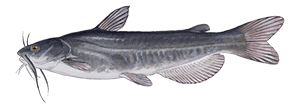White Catfish

Species Details
Ameiurus Catus
Ictaluridae
Siluriformes
Coastal River, Tidal Water
6 - 9 lbs.
13" - 24"
White Catfish (Ameiurus catus) Fish Description
The White Catfish, also known as the White Bullhead, appears blue-black to gray on its back. Unlike the other catfish, the White Catfish has no black blob-looking marking at the base of its dorsal fin. It has a yellowish-white underbelly like its other cousins but has a black adipose fin near its tail. The tail is slightly forked with rounded edges, similarly to the Flathead.
The White Catfish has eight barbels. It has two on its nose, two near its jaw, and finally, four on its chin. On both its dorsal and pectoral fins, it has a spine on the front side of the fins with several rays following after. Their lips are subterminal, making them more suited for bottom-feeding.
White Catfish Diet and Size
White Catfish are bottom feeders. They like feeding on aquatic insects and fish that usually loiter around in the sand. However, White Catfish also consume other crustaceans and aquatic plants.
White Catfish on average are pretty small and can be held in one hand. They usually weigh between half a pound to 2 pounds. But some have found White Catfish weighing 10 lbs.
Interesting Facts about the White Catfish
- White Catfish are considered the smallest among the North American catfishes.
- White Catfishes have white chin barbels which are where they most likely got their name from.
- This type of catfish likes feeding more at night so usually at dusk heading to night time.
- They’re not completely nocturnal, however.
- White Catfish don’t have scales like their other cousins but they do have a serrated spine.
- White Catfish are considered rare by anglers.
- An average White Catfish can only live up to 14 years.
- They become sexually mature after 3-4 years.
- People have usually caught small White Catfish but catching a large one is a dream for many anglers.
- White Catfish taste things by touching them with their barbels/whiskers.
- When it comes to laying their eggs, White Catfish can be quite particular about the temperature of the water.
White Catfish – Fishing Techniques: How to Fish for a White Catfish
Like any catfish, White Catfish prefer live bait. One of the most common baits to use for a White Catfish include worms and shrimp. However, if you can't find any of that, chicken liver is the usual staple for catfishes. Like most Catfishes, they do like live or smelly food as their bodies can “taste” the food when it gets to the water. White Catfish are no different. Processed bait and cut bait from smelly fish will do well also.
Unlike other Catfish, however, they are not as nocturnal. They can be caught in the morning. Common methods of catching a White Catfish include bait casting and bottom fishing. Baitcasting is different than your typical spin-cast due to the position of the reel. Unlike the usual, spin reels are on the side whereas bait-cast reels are on the rod itself. Since the bait-cast reel is on the rod itself, it can cover longer ranges in catching the White Catfish.
Bottom Fishing is when you let your bait sink down to the ground. However, let it slightly float around so the White Catfish can detect the bait instead of it having it loiter around in the sand.
White Catfish Habitat and Distribution
White Catfish prefer sluggish waters. They like freshwater bodies such as lakes, ponds, streams, and rivers. Sometimes, White Catfish can be found in reservoirs, drainages, and river backwaters. Provided, that the water is temperate at 82 Fahrenheit. White Catfish are also tidal water species so they follow often the behavior of the moon. Like any other catfish, the White Catfish prefers bodies of water with muddy bottoms. For them, that's where they can find the most crustaceans and fishes especially since they're bottom feeders. They also can survive in waters that are low in oxygen.
Despite their preference for freshwater bodies, White Catfish can tolerate brackish waters and sometimes can even found in deeper bodies of water. Their pathway usually follows the rivers that head towards the Atlantic Ocean.







